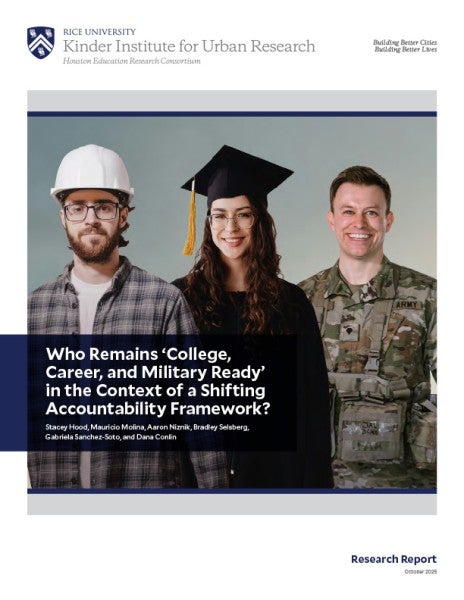The Texas A-F Accountability System uses College, Career, and Military Readiness indicators as a key component in measuring how prepared students are for postsecondary success.
What began in 2013 with a flexible graduation structure and reduced testing has evolved into a multifaceted rating system shaped by legislative directives, ongoing input from advisory committees, shifting workforce demands and a changing understanding of postsecondary success. While the system has been refined, its evolution has not been linear; it has faced disruptions such as the COVID-19 pandemic and misalignments between policy vision and implementation.
Why the research matters
Accountabilty frameworks are used to shape educational priorities, allocate resources and define readiness for college and careers. Metrics help identify disparities in opportunities and achievements for students.
Our study
Using a mixed-methods approach, this study investigates: 1) the development of the Texas framework, with specific attention to CCMR standards over time; 2) equity considerations during development; and 3) how changes affected CCMR rates across districts among different student groups.
Key findings
The last decade of accountability system change in Texas has been both ambitious and turbulent. Policymakers aimed to build a system that was transparent, rigorous and continuously aligned with evolving understandings of CCMR. Yet, in practice, translating these goals into a coherent, equity-focused and functional accountability framework proved challenging. Consequently, students from historically marginalized groups, particularly Black, Hispanic, and economically disadvantaged students, have lacked the support that can help them succeed.
Development of accountability system and CCMR framework
- Legistlative mandates and advisory board input shaped the system's design.
- Periodic disconnect between the Texas Education Agency (TEA) and its advisory committees undermined trust and weakened public stakeholders' role in shaping policy discussions.
- Complexities in developing a system that worked across diifferent school types hindered clarity, particularly for CCMR.
- Adjustments had to be made in response to continuous distruptions like evolving CCMR indicators and the COVID-19 pandemic.
Equity considerations
- The new system aimed to identify metrics that recognized the variety of postsecondary pathways available, creating a broader definition of postsecondary readiness.
- Despite equity discussions throughout the development process, achieving targeted equity goals was not a primary concern in the finalized policy.
Impact on school districts and students
- There were significant declines in CCMR rates upon implementation, followed by a slow and uneven recovery as districts adjusted to new standards.
- Rates are still not at pre-2017 levels, and some demographic groups have seen slower recovery, illustrating the fragility of the accountability system.
Insights on how the accountability system development process could have been better defined and formalized are provided along with recommendations on how to close persistent equity gaps.
This report is part of a series of research on innovative assessment approaches and alternative accountability models coordinated under The K12 Research for Equity Hub. The Hub is managed by EduDream and funded by the Gates Foundation and the Walton Family Foundation.
Suggested citation: Hood, S., Molina, M., Niznik, A., Selsberg, B., Sanchez-Soto, G., & Conlin, D. (2025). Who remains ‘college, career, and military ready’ in the context of a shifting accountability framework? Houston, TX: Houston Education Research Consortium, Kinder Institute for Urban Research, Rice University. DOI: https://doi.org/10.62137/BSBL7148




